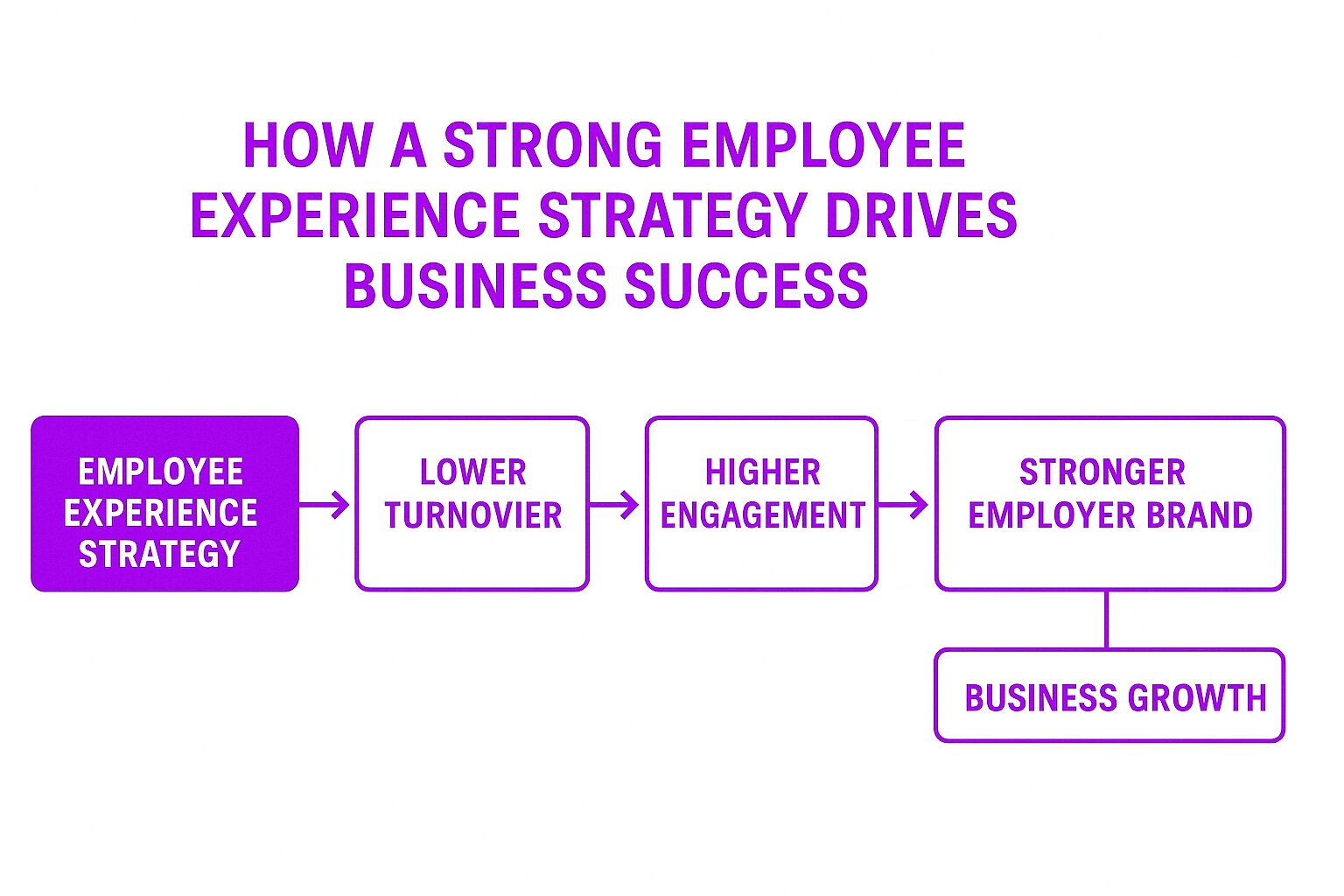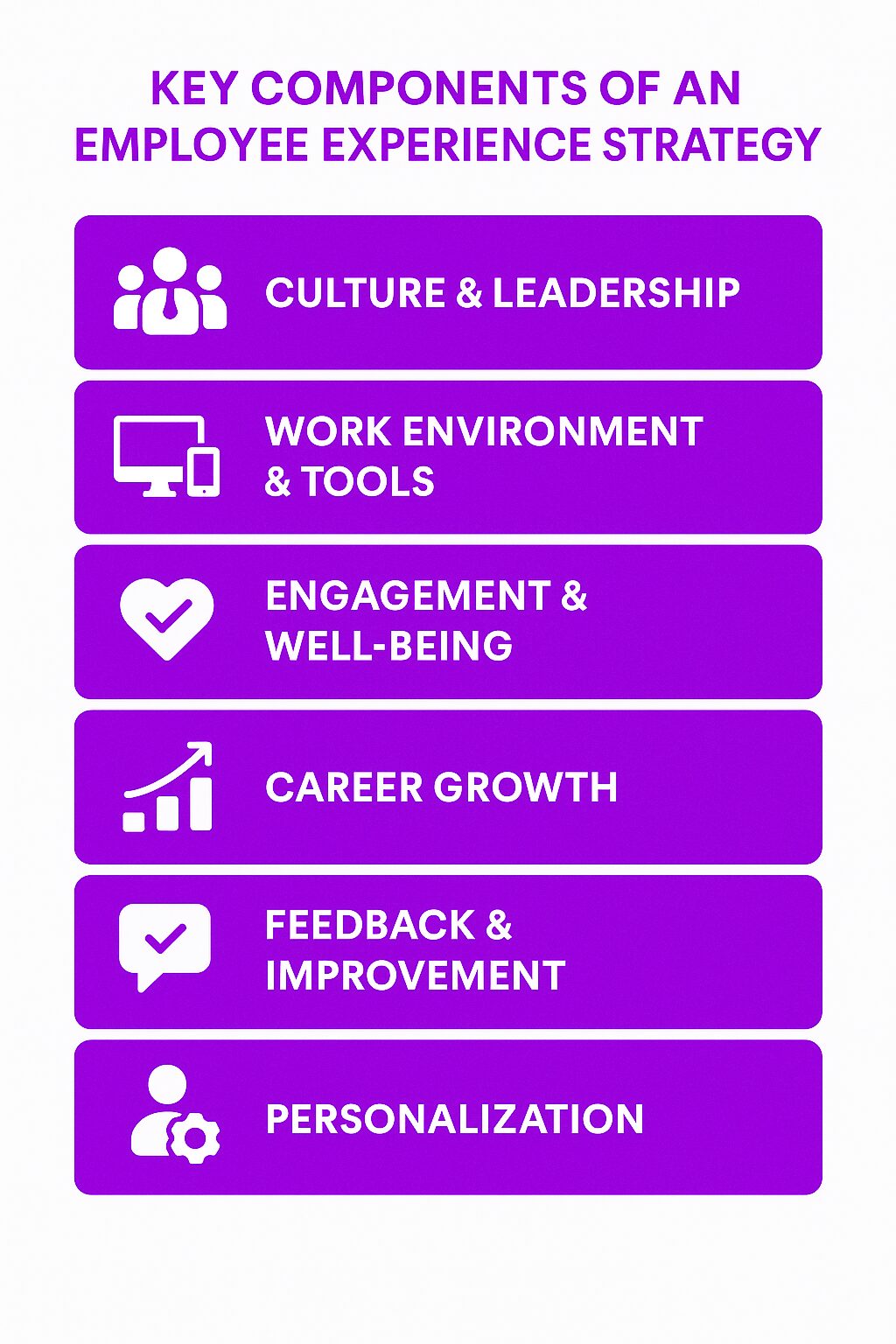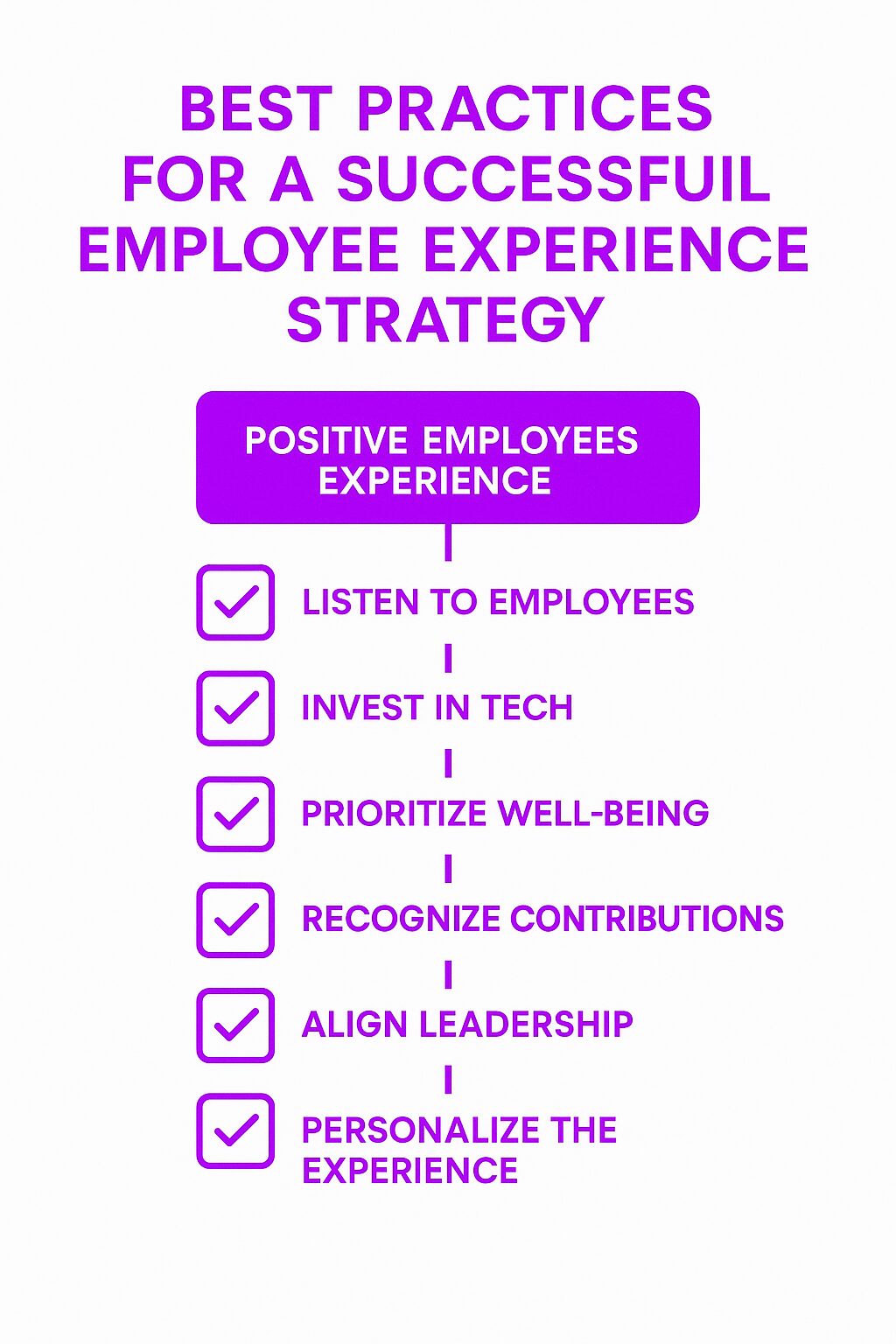What is an Employee Experience Strategy?
An employee experience strategy is a structured plan designed to enhance every interaction an employee has with their workplace. It includes workplace culture, technology, leadership, and daily processes that impact job satisfaction and engagement. A strong and effective employee experience strategy ensures employees feel valued, supported, and motivated to contribute to company goals.
Companies that develop and implement an employee experience strategy focus on more than just HR policies. They create an environment where employees can perform their best work, grow professionally, and stay engaged over time. Employee experience affects retention, productivity, and overall business success.
Definition of Employee Experience
Employee experience refers to the sum of all interactions and experiences an employee has with an organization, from the initial job application to their eventual departure. It encompasses everything an employee learns, does, sees, and feels at each stage of the employee lifecycle. This broad term covers all aspects of an employee’s journey, including cultural experiences, user experiences, and physical workspace environments. By understanding and optimizing these interactions, organizations can create a more engaging and supportive environment that enhances overall job satisfaction and performance.
Why Employee Experience Matters
Employees want more than a paycheck. They seek a work environment that is engaging, inclusive, and rewarding. A positive experience leads to increased commitment and productivity, while a poor experience results in disengagement and turnover.
Organizations that prioritize employee experience attract and retain top talent. Effective employee retention strategies, such as onboarding, career development, and leadership support, are crucial in maintaining a positive employee experience. Engaged employees provide better service, drive innovation, and contribute to a stronger company culture. Companies that neglect employee experience often struggle with low morale, burnout, and high turnover costs.
Competitive Advantage
In today’s competitive job market, focusing on employee experience is a key differentiator for organizations. A positive employee experience can lead to increased employee engagement, retention, and productivity, ultimately driving business success. According to research by Jacob Morgan, companies that invest in employee experience are four times more profitable than those that do not. By prioritizing employee experience, organizations can create a competitive advantage that sets them apart from others in their industry. This focus not only attracts top talent but also fosters a loyal and motivated workforce that contributes to long-term success.
Business Impact of Employee Experience
Employee experience has a significant impact on business outcomes. Research shows that companies with high employee engagement and positive employee experiences are more likely to see improved customer satisfaction, increased productivity, and better financial performance. For instance, organizations that prioritize employee experience often report lower turnover rates and reduced recruitment costs, as engaged employees are more likely to stay with the company. By investing in employee experience, businesses can drive success and achieve their goals, creating a virtuous cycle of engagement, performance, and retention.
Key Components of an Employee Experience Strategy
Culture and Leadership
A company’s culture shapes how employees interact with their colleagues and leadership. Transparent communication, respect, and recognition create an environment where employees feel valued. Leadership plays a critical role in reinforcing this culture by setting expectations and supporting employee development.
Work Environment and Tools
Employees need the right tools and resources to perform their jobs efficiently. Modern collaboration platforms, clear processes, and a supportive work environment improve the employee experience. Organizations should ensure that digital and physical workspaces support productivity and engagement.
Employee Engagement and Well-being
Employee well-being and an employee’s experience impact motivation and performance. Companies that invest in wellness programs, mental health support, and flexible work arrangements see higher levels of engagement. Simple actions like recognizing employee achievements or providing career development opportunities contribute to a positive experience.
Career Growth and Learning
Employees stay engaged when their employee journey includes opportunities for growth. Providing learning programs, mentorship, and career progression paths ensures employees see a future with the company. Without these opportunities, employees may seek career advancement elsewhere.
Feedback and Continuous Improvement
Employee experience is not a one-time initiative; it requires a well-defined employee experience framework to ensure continuous improvement. Companies must regularly collect feedback and adjust their approach to meet changing employee needs. Surveys, one-on-one meetings, and engagement tools help organizations understand and address concerns before they escalate.
Purpose and Importance of an Employee Experience Strategy
A successful employee experience strategy is not just an HR initiative—it is a business necessity. It helps organizations create a work environment where employees can thrive, leading to better retention, higher engagement, and improved performance. The strategy aligns company goals with employee needs, ensuring that employees remain motivated and productive.
Businesses with strong employee experience strategies often see:
-
Higher job satisfaction
-
Increased productivity and efficiency
-
Stronger employer branding
-
Better customer experiences, as engaged employees contribute to better service
Benefits and Challenges of Employee Experience Strategy
Benefits
-
Higher Retention Rates: Employees who feel valued are more likely to stay with the company, improving employee retention.
-
Improved Productivity: Engaged employees work more effectively and contribute more ideas.
-
Stronger Workplace Culture: A clear strategy fosters transparency, teamwork, and collaboration.
-
Enhanced Employer Brand: Organizations with a strong employee experience attract top talent.
Challenges
-
Leadership Buy-In: If leadership does not support the strategy, it is unlikely to succeed.
-
Measuring Employee Experience: Defining success and tracking progress can be complex.
-
Adapting to Change: The workplace is constantly evolving, requiring continuous adjustments to the strategy.
-
Technology Integration: Implementing new tools and ensuring employees adopt them can be difficult.
Best Practices for Implementing an Employee Experience Strategy
Listen to Employees
Employees know what they need to perform their best work, and understanding the employee’s journey is crucial in this process. Gathering feedback through surveys, interviews, and focus groups provides insights into areas that need improvement.
Invest in the Right Technology
Digital tools shape the employee experience. Investing in communication platforms, self-service HR tools, and learning management systems enhances engagement and productivity.
Prioritize Employee Well-being
Flexible work options, wellness programs, and mental health support help employees manage stress and maintain work-life balance.
Recognize and Reward Contributions
Employees want to feel valued. Regular recognition—whether through bonuses, promotions, or simple acknowledgments—motivates employees and reinforces positive behaviors.
Ensure Leadership Alignment
Managers must be trained to support and advocate for the employee experience strategy. Leadership plays a key role in reinforcing workplace culture and engagement initiatives.
Personalize the Experience
Different employees have different needs. Offering personalized benefits, development plans, and work arrangements ensures a more inclusive and engaging work environment.
Measuring Employee Experience
Measuring employee experience is crucial to understanding its impact on business outcomes. There are several ways to measure employee experience, including surveys, feedback tools, and performance metrics. Regularly collecting employee feedback through surveys and one-on-one meetings helps organizations identify areas for improvement and track progress over time. Additionally, using engagement tools and analytics can provide insights into employee satisfaction and engagement levels. By continuously monitoring and adjusting their approach, companies can ensure they are meeting the evolving needs of their workforce and driving positive business results.
Related Concepts
Employee Engagement
Employee engagement refers to the level of commitment and motivation employees have toward their work. A strong employee experience (EX) fosters engagement, leading to better performance and satisfaction.
Workplace Culture
Company culture includes shared values, behaviors, and work norms. A positive culture creates an environment where employees feel included and motivated.
HR Technology
HR technology includes digital tools that support recruitment, onboarding, training, and performance management. These tools play a crucial role in shaping employee experience.
Remote Work Experience
With the rise of remote and hybrid work, organizations must adapt their employee experience strategies to ensure remote employees remain engaged and connected.
Real-World Examples of Employee Experience Strategies
Google invests heavily in employee experience by offering flexible work options, professional development programs, and employee recognition initiatives. The company’s culture encourages innovation and collaboration.
Microsoft
Microsoft uses its own platform, Microsoft Viva, to enhance employee engagement and well-being. The company prioritizes continuous learning and career growth.
Facebook (Meta)
Facebook developed Workplace, an internal platform that fosters communication and collaboration. The company also invests in employee wellness programs and flexible work arrangements.
Datto
Datto improved its employee experience by adopting digital tools that enhanced communication and collaboration. The onboarding process was also streamlined, ensuring new hires received adequate support and training feedback surveys, which are crucial for ongoing development and employee retention. This shift increased intranet adoption from 7% to 100%, leading to a more connected workforce.
The Future of Employee Experience Strategy
The workplace continues to evolve, and companies must adapt their employee experience strategies to meet new challenges. The future of employee experience includes:
-
Greater focus on personalization, tailoring experiences to individual employee needs.
-
Increased use of AI and automation to streamline processes and improve engagement.
-
Enhanced remote work strategies to support hybrid teams.
-
More emphasis on mental health and well-being initiatives.
Organizations that invest in employee experience will be better positioned to attract and retain talent, drive engagement, and maintain a competitive edge. A well-designed strategy creates a workplace where employees feel valued, supported, and motivated to succeed.








